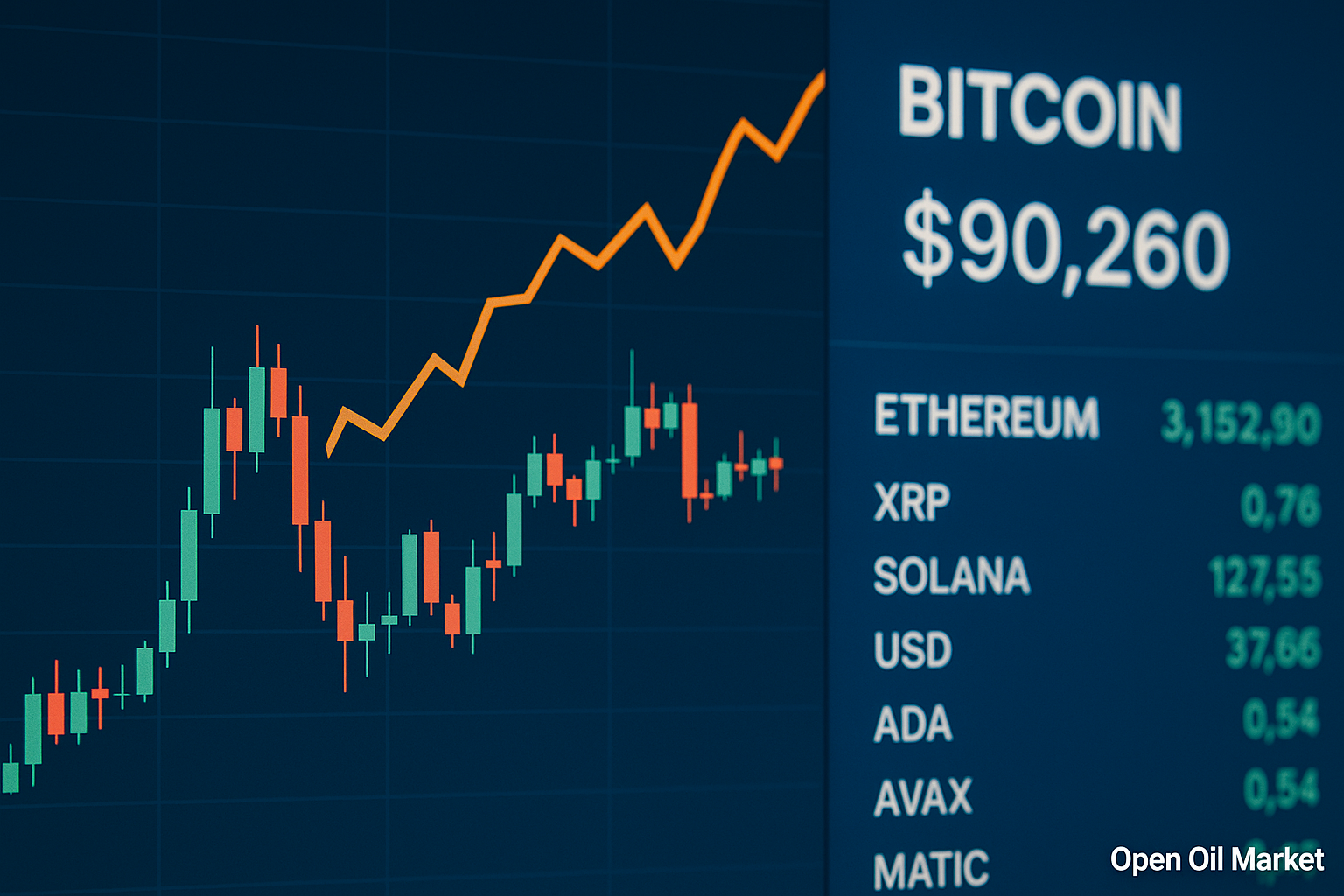
Global Cryptocurrency News as of November 7, 2025: Bitcoin Maintains Upward Trend, Ethereum Prepares for Major Upgrade, Altcoins Show Mixed Dynamics. Institutional Interest in Digital Assets Grows Amid Fed's Loose Policy.
Bitcoin: Consolidation After Correction
The largest cryptocurrency, Bitcoin (BTC), set a new all-time high this fall, surpassing $125,000, before undergoing an expected correction. In early November, the price briefly dropped to around $105,000, but soon stabilized around $110,000. The area near $105,000 serves as important support: holding BTC above this level sustains the upward trend. The nearest resistance zone is positioned around $120,000—confident growth beyond this mark will pave the way for Bitcoin to achieve new records.
The factors that fueled the BTC rally remain intact. Investors are anticipating a forthcoming easing of monetary policy in the U.S. (with expectations for the Fed to lower rates), which traditionally boosts demand for risk assets, including cryptocurrencies. Institutional players continue to ramp up investments in Bitcoin through exchange-traded funds (ETFs) and other products. At the same time, risks persist: an unexpected surge in inflation or stern statements from the Federal Reserve could temporarily cool the market.
Ethereum: Upward Trend Ahead of Upgrade
The leading altcoin, Ethereum (ETH), is also demonstrating robust growth in 2025. After a brief decline in early November (to around $3,600), Ether has rebounded to the $3,800-$4,000 range, significantly above the year's beginning levels and close to its historical peak (~$4,867). ETH is supported by high institutional interest and strong fundamental factors. The launch of the first spot ETF for Ethereum in the U.S. is anticipated, and a significant network upgrade aimed at enhancing scalability and reducing transaction fees is scheduled for early December. The ongoing development of the smart contract ecosystem and deflationary issuance model reinforce Ethereum's standing as a high-tech asset. Many market participants expect that in the coming months, ETH will surpass the $4,600 mark and set new highs.
Altcoin Market: Trends
Major altcoins have experienced significant growth in recent months; however, volatility increased at the end of October and early November, leading to a pullback for several coins from their peaks. Some top assets are holding near multi-year highs: for instance, XRP is currently trading around $3.0 (surpassing $3 for the first time since 2018 following Ripple's victory over the SEC), while BNB recently reached approximately $850. Solana (SOL) has stabilized around $180, driven by the expansion of its ecosystem and the launch of its first SOL-based fund. Overall, the dynamics among altcoins remain mixed, but investor interest persists—especially in projects with a strong technological foundation and the potential for ETF launches.
Record Institutional Investor Interest
One of the main trends of 2025 has been the sharp increase in institutional capital engagement in the cryptocurrency market. Banks, funds, and corporations are ramping up investments in digital assets, as evidenced by capital inflows into crypto funds and the emergence of new instruments (including exchange-traded ETFs). Experts compare the current situation to the early 2010s in the gold market when major players incorporated gold into their reserves—today, a similar process is unfolding with Bitcoin, which many institutions view as a strategic reserve asset. Although some partial asset sales were recorded following price peaks in the fall (over $1 billion was withdrawn from U.S. crypto ETFs in the last week of October), the overall trend remains bullish. Major investors are using every significant price drop to accumulate more, forming a strong foundation for the market's further growth.
Regulation in the U.S. and Europe: New Rules
In the United States, decisions are looming that could set the "rules of the game" for the crypto industry for a long time. In the summer, the House of Representatives approved the Digital Asset Market Clarity Act (CLARITY Act), aimed at creating a clear regulatory framework for cryptocurrencies and exchanges; now, the relevant Senate committee is considering its own version. The industry holds high hopes for these initiatives, but until the law is enacted, investors remain cautious. Simultaneously, regulators are showing a warming attitude: the new SEC leadership states that only a small portion of tokens fall under securities laws and is preparing clear criteria for digital assets. The SEC has already withdrawn several lawsuits against major exchanges, marking a shift towards more flexible policy. Additionally, the Trump administration made an unprecedented move by pardoning Binance founder Changpeng Zhao (CZ), previously convicted of violating financial regulations. Collectively, these measures are creating a more favorable regulatory environment for the U.S. crypto market. In Europe, the Markets in Crypto-Assets (MiCA) regulation is coming into effect, establishing common requirements for the industry. Several major crypto companies have already obtained licenses under the new rules, ensuring predictable conditions for business and a balance between innovation and investor protection.
Global Trends and Initiatives
Important developments are also occurring in other regions of the world. In China (through the financial hub of Hong Kong), plans are underway to launch the first stablecoin pegged to the yuan, while Brazil is discussing the inclusion of Bitcoin in its national reserves (up to 5% of its foreign reserves). Many countries are striving to become crypto hubs—UAE and Singapore, for instance, are attracting blockchain businesses through progressive regulation. These steps indicate that governments worldwide are integrating cryptocurrencies into the financial system, acknowledging their growing role in the economy.
Top 10 Most Popular Cryptocurrencies
- Bitcoin (BTC) — ~$110,000 (≈55% of the market). Limited issuance (21 million coins) gives BTC characteristics of "digital gold," with high demand.
- Ethereum (ETH) — ~$4,000 (≈13% of the market). Leading smart contract platform. The transition to PoS and deflationary issuance model have strengthened ETH's position as a high-tech asset.
- Tether (USDT) — ~$1.00. The largest stablecoin, pegged to the U.S. dollar 1:1. A key source of liquidity in the crypto market, enabling rapid "parking" of capital between trades.
- Binance Coin (BNB) — ~$800. Token of the Binance exchange ecosystem (BNB Chain). Used for transaction fee payments and access to services. Despite regulatory pressure, BNB remains in the top-5 due to its wide range of applications.
- USD Coin (USDC) — ~$1.00. The second-largest stablecoin (issued by the Circle and Coinbase consortium). Full reserve backing and regular audits have made USDC a beacon of reliability and regulatory compliance.
- XRP (Ripple) — ~$3.0. The Ripple network token for fast cross-border payments. In 2025, XRP surpassed $3 for the first time since 2018 due to Ripple's victory over the SEC and expectations for the launch of an XRP ETF.
- Solana (SOL) — ~$180. A layer-one blockchain known for high transaction speeds and low fees. SOL significantly rose in value following the expansion of its ecosystem (DeFi, NFT) and the launch of its first ETF.
- Cardano (ADA) — ~$0.80. A blockchain platform with a Proof-of-Stake algorithm and a science-oriented development approach. Although ADA's price is far from record highs, the coin remains in the top-10 due to its large market capitalization and active community.
- Dogecoin (DOGE) — ~$0.22. The most well-known "meme" cryptocurrency, ranking among the top coins. Popular for microtransactions and internet tipping. Thanks to its loyal community and occasional bursts of excitement, DOGE maintains its position among the leaders, though it exhibits significant volatility.
- TRON (TRX) — ~$0.35. The token of the Tron platform. It strengthened amid the increased use of the network for issuing stablecoins and asset tokenization. Low fees and high throughput helped TRX secure a spot among the top 10 coins.
Thus, as of November 7, 2025, the cryptocurrency market continues to hold at high levels. Fundamental factors—the influx of institutional capital, technological development of blockchain platforms, and the easing of regulatory policies—create a positive backdrop for further growth. However, some uncertainty remains. Upcoming events, such as the possible approval of new crypto ETFs and the forthcoming Ethereum upgrade, may provide new momentum for the market as the year comes to a close.




